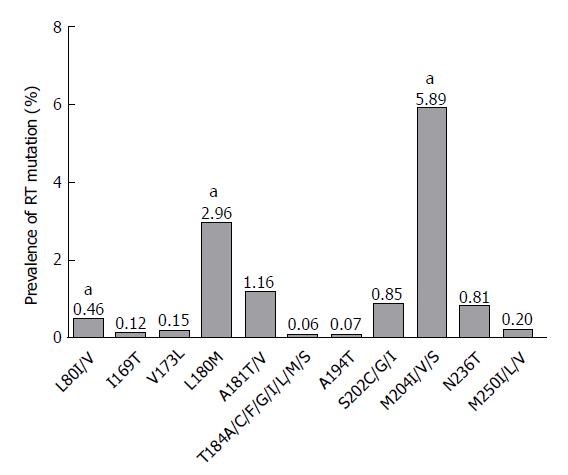Copyright
©The Author(s) 2018.
World J Gastroenterol. Apr 28, 2018; 24(16): 1708-1724
Published online Apr 28, 2018. doi: 10.3748/wjg.v24.i16.1708
Published online Apr 28, 2018. doi: 10.3748/wjg.v24.i16.1708
Figure 1 Pooled incidence and distribution of preexisting primary and secondary reverse transcriptase mutations compiled using data from 50 previous studies.
The distribution and overall incidence of RT region is presented; numbers indicate the pooled incidence rate of the RT mutation in a total of 8,435 treatment-naïve patients. aPre-existing RT mutation associated with the progression of HCC in treatment-naïve patients.
Figure 2 Pooled incidence and distribution of preexisting putative and pretreatment reverse transcriptase mutations compiled using data from 50 previous studies.
The distribution and overall incidence of RT region is presented; numbers indicate the pooled incidence rate of the RT mutation in a total of 8435 treatment-naïve patients. aPre-existing RT mutation associated with the progression of HCC in treatment-naïve patients; bA-B interdomain region.
Figure 3 Schematic representation indicating the role of preexisting hepatitis B virus reverse transcriptase mutations in liver disease progression and treatment outcomes.
HBV: Hepatitis B virus; HCC: Hepatocellular carcinoma; ASC: Asymptomatic carriers; CHB: Chronic hepatitis B; HIV: Human immunodeficiency virus.
- Citation: Choi YM, Lee SY, Kim BJ. Naturally occurring hepatitis B virus reverse transcriptase mutations related to potential antiviral drug resistance and liver disease progression. World J Gastroenterol 2018; 24(16): 1708-1724
- URL: https://www.wjgnet.com/1007-9327/full/v24/i16/1708.htm
- DOI: https://dx.doi.org/10.3748/wjg.v24.i16.1708











